
Only 0,02% of the drug molecules contained in eye drops enter the eye with each application. That’s why—after cataract surgery, for example—patients have to put anti-inflammatory drops in their eyes every day for several weeks. The drops actually run into the eye’s tear film, which constitutes an important defense against dust, pollen and medication.
Élodie Boisselier, researcher at the CHU de Québec Research Centre and professor in the Faculty of Medicine at Université Laval1, has proposed to use gold nanoparticles to circumvent the barrier and send the entire dose of the treatment to the cornea or deeper into the eye.
In the lab, she showed that drugs can be encapsulated in a small gold sphere coated with polyethylene glycol. By stabilizing the metal with sulfur, the transport nanoparticles bind to the sulfur contained in mucins, which are proteins that form part of the tear film. The gold capsules would remain stuck to the eye while the drug is absorbed and gets to work.
The researcher and her colleagues recently led tests on post-mortem rabbit eyes. They dissected the different parts of the eye to assess the distribution of the gold nanoparticles (no drug) on the surface of the cornea, as well as the nanoparticles’ toxicity, stability and elimination by the body. If the results are conclusive, the experts will assess the effectiveness of drug encapsulation, including the percentage of therapeutic molecules that make it through.
The method to create the gold nanocapsules was patented, and the team thinks it may even be possible to adapt the nanoparticles’ properties based on each patient’s specific type of tear film to increase their adherence to the eye’s barrier.
Of course, clinical trials on animals and human must still be conducted before we can hope to be golden-eyed! Still, Élodie Boisselier believes we will one day be able to reduce the frequency of eye drop treatments and perhaps even find an alternative to the eye injections required to slow the progression of macular degeneration.
1Élodie Boisselier is also a member of the following FRQNT and FRQS strategic clusters: PROTEO, the Québec Centre for Advanced Materials (QCAM) and the Vision Health Research Network (VHRN).
